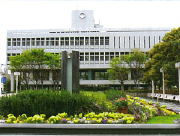ホーム > くらし > 国際交流 > About Ashiya City/芦屋市について > A Brief History of Ashiya/ 芦屋市の歴史
ここから本文です。
更新日:2021年1月29日
A Brief History of Ashiya/ 芦屋市の歴史
Blessed with a wondrous natural environment and a moderate climate, Ashiya has been a prime residential area since ancient times.
It is also surrounded by the Rokko mountains to the north and Osaka Bay to the south, adding to the beautiful scenery of Japan’s four seasons.
In the literature of the Heian Period (794-1191), Ashiya was mentioned in connection with Prince Abo and his son Narihira Ariwara, a famous poet, and thereby earned respect and esteem from members of the imperial court. Therefore, Ashiya often appeared not only in the Manyousyu, the oldest Tanka Poetry collections in the world, and Isemonogatari, a collection of one hundred twenty-five stories, but also other Japanese classic literature.
During the Kamakura Period (1192-1333), this normally peaceful area was exposed to the horrors of war.
Under this vortex of wars, people in Ashiya banded together against their enemies. Thus, at the end of the Sengoku Period (1491-1573), four villages, Uchide, Ashiya, Sanjo, and Tsuji were formed.
After the Meiji Restoration in 1889, the first modern constitution was promulgated in Japan. The four villages, Uchide, Ashiya, Sanjo, and Tsuji were consolidated into one village, which was named Seido. The name Seido was taken from the name of a school called Seido Elementary School.
On November 10, 1940, the fully developed village became the 173rd city in Japan (there are about 670 cities now).
The well-known name of an area of Seido Village, “Ashiya,” was adopted as the name of the city. In 1951, the Japanese government proclaimed the “Ashiya International Cultural Residential City Construction Act” to promote the city as an international culturally diversified city. This act has drawn a great deal of interest to the planning and development of the city.
“The Great Hanshin-Awaji earthquake” that struck southern Hyogo Prefecture on January 17th, 1995, wreaked destruction on Ashiya, resulting in the highest damage rate in the Hanshin area. We lost the precious lives of 444 people, and 92.5% of all residences were damaged, shaking the foundation we had built up over such a long time as a residential city. For following eight years, we gave priority to restoration and recovery, and promoted the installation of basic utilities, street maintenance of each district, restoration of the parks and sports grounds, and construction of the Minami Ashiya Hama Disaster Recovery Public Housing.
In 2004, the Ashiya City Mayor issued a proclamation naming our city “Ashiya Garden City,” with the aim to make Ashiya “the city, everyone in the world would like to visit once in his/her life” – a city full of flowers in a beautiful natural environment.
Now, we are striving as one to help the city fully recover, in order to create a cosmopolitan atmosphere that will continue throughout the 21st century.
美しい自然と温暖な気候に恵まれ、芦屋は古くから高級住宅地として知られています。
北には緑豊かな六甲の山々が連なり、南に大阪湾を望み、日本の四季の彩りがあふれる環境です。
平安時代(794~1191年)の文学では、芦屋は阿保新王及びその息子、著名歌人である在原業平との縁によって朝廷で名高く、尊敬されていました。芦屋は、世界で最も古い歌集である万葉集や125の歌物語からなる伊勢物語の他、日本の古典文学にたびたび取りあげられています。
鎌倉時代(1192~1333年)には、ふだんは平和な里は戦いの舞台となりました。
こうした戦乱の中で、芦屋の人々は結束を固めていきます。そして戦国時代の末には、打出・芦屋・三条・津知という四つの村が誕生しました。
明治維新以後、明治22年(1889年)に日本で初の近代憲法が発布されました。芦屋村・打出村・三条村・津知村の四村が合併して「精道村」が誕生し、その名は当時ありました精道小学校に由来します。
昭和15年(1940年)11月10日に、芦屋は全国で173番目の市となりました(現在、全国670市)。
精道村には、「芦屋」というよく知られた地区があり、それが市名として採用されました。昭和26年(1951年)には、日本政府が芦屋を「国際文化住宅都市」に指定し、“国際性と文化性に富む都市の形成”という目標のもと、住宅都市づくりが進められました。芦屋市の都市計画及び発展に大きな影響を与えました。
しかし、平成7年(1995年)1月17日、兵庫県南部を襲った阪神淡路大震災は芦屋に大きな破壊を引き起こし、結果として阪神間で最も高い損壊率を記録しました。444名の尊い命が失われ、92.5%の建物が損害を受け、長年にわたって営々と築いてきた住宅都市の基盤を揺るがしました。その後の8年間は、復旧・復興事業を優先し、重点的にインフラ基盤強化に取り組み、各地区の道路整備、公園及びスポーツ施設の復旧、そして南芦屋浜の復興公営住宅の建設を進めました。
平成16年(2004年)には、芦屋市長が「庭園都市」を宣言し、美しい自然の中で花あふれるまちづくりを進め、世界中の人たちに一度は行ってみたいと思われるような都市を目指しています。
芦屋市民が一丸となって、市の復興を成し遂げ、国際的雰囲気を醸し出し、21世紀を通じて継続するよう願っています。


